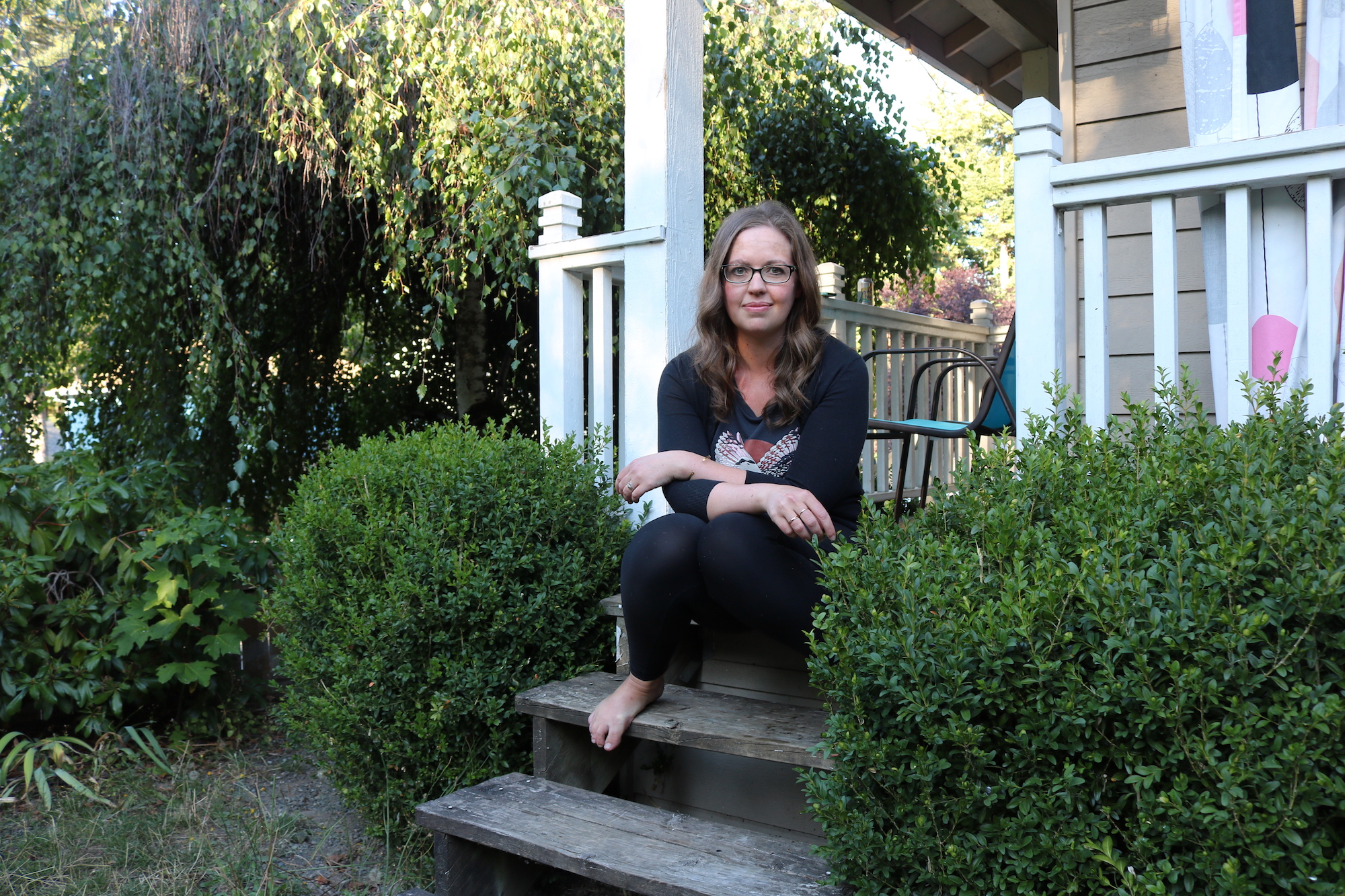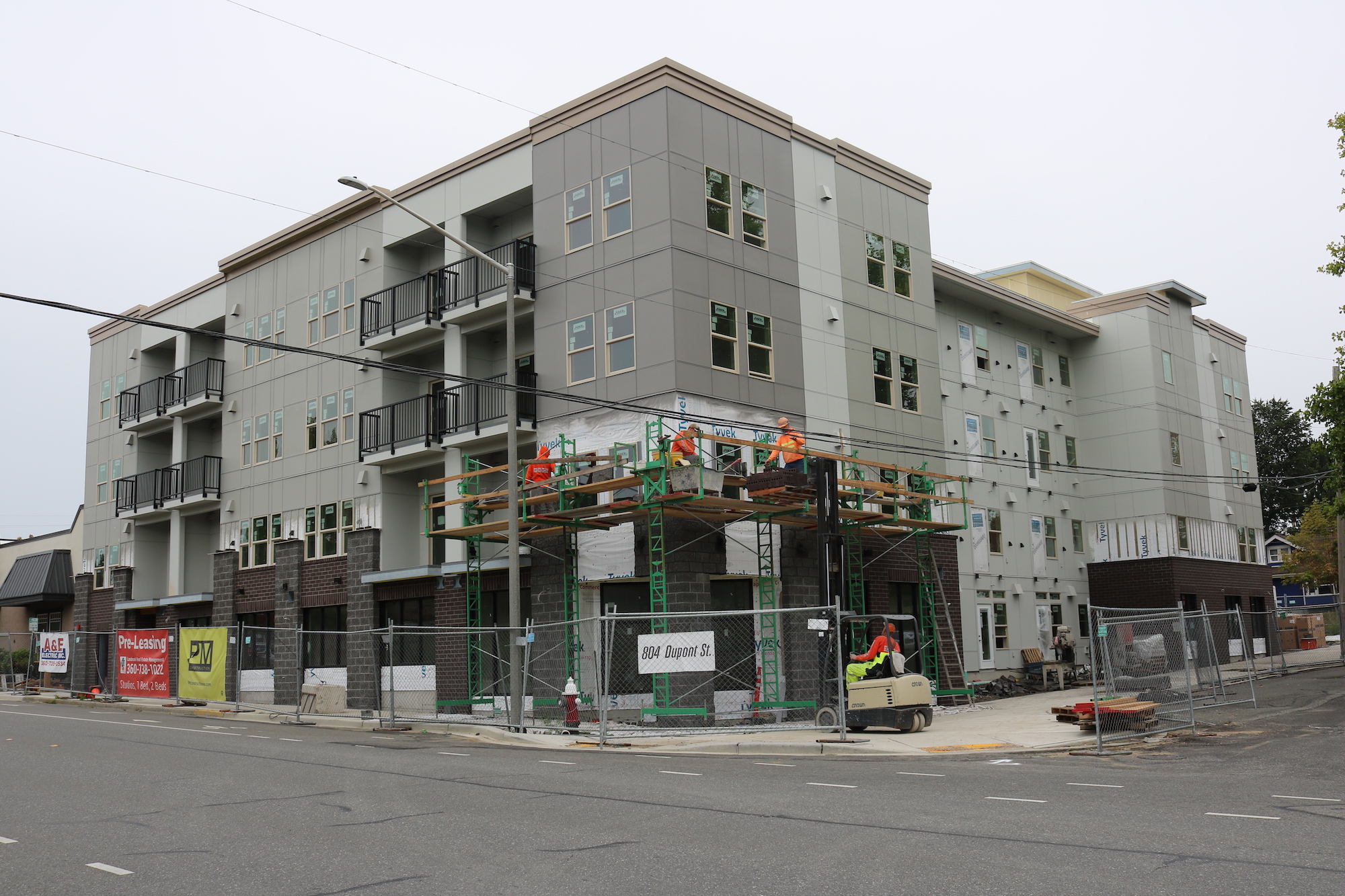This story is part of the series Getting to Zero: Decarbonizing Cascadia, which explores the path to low-carbon energy for British Columbia, Washington, and Oregon. This project is produced in partnership with InvestigateWest and other media outlets.
In late 2019, mere weeks before the first coronavirus case in the U.S. was detected 60 miles south, the city council of Bellingham, Washington, gathered for a presentation from the town’s Climate Action Plan Task Force, a group of nine community members charged with drawing up a roadmap for Bellingham to hit its emission-cutting goals.
In front of a packed house, the task force walked the council through its 50-odd recommendations for the better part of an hour and a half. One of the recommendations split the audience like no other: whether natural gas should be phased out of buildings in Bellingham and replaced with electricity, beginning with new construction, and gradually spreading to existing commercial businesses and homes. Furnaces would be swapped for heat pumps — which run on electricity and can both heat and cool buildings — hot water heaters extracted for electric boilers, and gas stoves and ovens replaced with electric or induction models.
A public comment period later that day ran for nearly two hours. A vast majority of those in opposition to the measure were members of the natural gas, building, and real estate industries, joined by a handful of community members.
An older man wearing a red Trump 2020 hat stepped to the lectern to call the task force’s presentation “idiotic.” Another commented: “How many people really believe that cooking and heating their home in the winter with fire is a critical threat to mankind? I’m sorry, it just doesn’t resonate with me.” A third warned the city council that without gas, no restaurants or small businesses would survive. The calmer sort asked the city council to keep studying the costs and feasibility of electrification.
Local environmental groups had brought other community members to speak up for the measure. There was the owner of a local green construction company, who guaranteed that he could build all-electric homes for market rate. There was the 18-year-old woman who urged the local government to act on climate change for the benefit of her generation.
And then there were the parents, concerned for their children’s future on an overheated planet. “We can’t breathe carbon dioxide, and we can’t eat money,” one said. “When my kids look at me in 20 years, I don’t want them to say ‘You didn’t do anything.’”
In 2018, Bellingham committed to slashing its emissions 85 percent below 2000 levels by midcentury, then began gathering the task force, which would disband in December 2019 after its final recommendations to City Council. One of its nine members, Erin McDade, works for Architecture 2030, a nonprofit pushing to decarbonize buildings. She was convinced that the city couldn’t reach that target if natural gas continued to be burned in homes and businesses. “Using on-site fossil fuels in our buildings is not compatible with being carbon-neutral,” she said. “Whether [the city] knew it or not, when they wrote that in the Climate Action Plan, they were already having that conversation.”

Buildings are a formidable source of planet-warming pollution: Combustion of fossil fuels within them accounts for nearly one-tenth of U.S. emissions — a contribution that triples if you account for the energy sources used off-site to generate electricity. In Bellingham, the building sector accounts for 43 percent of the city’s total emissions, according to a 2018 update to the city’s Climate Action Plan. With many states ramping up efforts to power their grids with clean energy sources like wind and solar, experts consider what’s known as electrification a crucial piece of the decarbonization puzzle.
Real estate developers already have most of the technology to replace furnaces with heat pumps, hot water heaters with electric boilers, and gas stoves with induction cooktops. And because cities and towns control building and energy codes, it’s one of the few areas where they have the power to push through deep emission cuts.
During her time on the Climate Action Plan Task Force, McDade conducted an unofficial study of how much Bellingham could reduce emissions if it required all newly constructed commercial and multifamily buildings taller than three stories to be entirely electric. (Washington state does not allow cities to alter energy codes for single-family homes and two- and three-story multifamily buildings.) She estimated that by 2035, new buildings would be responsible for 17 percent of the city’s building-sector emissions. The city council had the power to avoid all of that.
When McDade first raised the idea in 2018, no cities in the country had banned natural gas in new construction. That’s no longer the case.

Berkeley, California, led the charge in July 2019, when it became the first city in the U.S. to pass such a law. Others have followed suit, including 48 other municipalities in the Golden State. Seattle then passed legislation earlier this year phasing out natural gas in all new commercial buildings and apartment buildings taller than three stories. And the bans may take off in the Northeast soon, with new building-electrification codes in development in municipalities in New York, Vermont, and Massachusetts.
These ordinances have ripple effects that spread beyond city limits, said Alex Ramel, a state representative from Bellingham and an activist with the North American environmental advocacy group Stand.earth. They can inspire similar legislation in nearby towns, as happened in California, or in statehouses.
Earlier this year, Ramel introduced a bill in the Washington State House of Representatives that would prevent new construction from using natural gas for space and water heating by 2030. Even with the roughly decade-long buffer, it died in committee.
“There are still plenty of folks that I would talk to about this, and they’d say ‘Well, can we even do that? Is that efficient? Is it affordable? Is there enough electricity in the grid?’” said Ramel. “There are good answers to all those questions, and if you can say, ‘Yes, I can explain to you why there are good answers,’ that’s one thing.
“If you can say ‘We’re doing it in Bellingham, it’s fine,’ that’s a quicker answer and sometimes more compelling.”
Ramel might soon be able to tout Bellingham as an example. City staff are now drafting an ordinance based on Seattle’s, three years after Erin McDade first advocated for the idea. The delay is not just a result of the slow grind of local government. Bellingham has had to contend with the natural gas industry’s well-funded national campaign against electrification.
Still, if all goes to plan, the city council should be mulling the proposal this winter. The question is whether the city will act more swiftly on existing building electrification, making it one of the first municipalities in the country to do so.
“Knowing what we need to do is the easy part,” McDade said. “How we implement it is, of course, the complicated part — and where the rubber meets the road.”

Bellingham is a progressive college town in a blue state that’s surrounded by nature and brimming with outdoors enthusiasts. The port city sits on the ecologically abundant Salish Sea and is bordered by evergreen forests whose silhouettes cut across vibrant West Coast sunsets. On clear days, the snow-capped Mount Baker is visible from downtown. It seems like a place where passing aggressive action on climate change would be relatively painless.
In 2005, the city council committed to the Cities for Climate Protection Campaign, a global initiative enlisting municipalities to take measurable steps toward cutting their emissions and becoming more sustainable. In accordance, Bellingham released its Climate Protection Action Plan two years later, leading to the task force McDade joined.
The nine people on the task force were volunteers, with one exception: Lynn Murphy, an employee of the local utility Puget Sound Energy who represented the interest of her employer, as well as Cascade Natural Gas, another utility. From McDade’s perspective, everyone on the task force except Murphy believed in the goal of mapping the city’s road to zero emissions. When the group voted on its final recommendations to the city council in 2019, all the measures passed unanimously, except those relating to building electrification and a handful regarding renewable energy generation. Murphy was the only one who voted against them.
In an email to Grist, Murphy touted her 13 years advancing clean energy initiatives in the community. She saw it as her job to weigh the merits of different actions. “My work on the task force was to evaluate the feasibility, costs, and impacts of proposed climate action measures as directed by the [City] Council’s resolution.” Puget Sound Energy, her employer, said that it “felt some of the measures lacked feasibility and understanding of the potential negative impacts to our customers,” according to Janet Kim, the utility’s public relations manager.
Alyn Spector, an energy efficiency policy manager at Cascade Natural Gas, said in an email to Grist that the region cannot afford to limit innovation to “a single fuel source or technology, which is the basis of electrification.” The company believes that the best process empowers utilities to “embrace a suite of decarbonization solutions,” he added, including improved energy efficiency, hydrogen, and renewable natural gas.

Renewable natural gas is a catch-all term for methane captured from landfills, wastewater treatment plants, and the manure pits found on animal farms. Environmental organizations have criticized its use in buildings on the basis that it is too expensive, in limited supply, and introduces similar safety and health risks as natural gas, namely methane leaks, pipeline explosions, and pollution from nitrogen oxide, carbon monoxide, and particulate matter.
The opponents of electrification launched a public relations campaign not long after it became clear that building electrification would likely be included in the task force’s final recommendations to city council. A local building industry group, with the support of Cascade Natural Gas, dispensed pamphlets to homeowners in the latter half of 2019 claiming that electrifying the typical existing Bellingham home would cost between $36,050 and $82,750.
The pamphlet, which features data from Puget Sound Energy as well as fossil fuel and construction companies, concluded that the conversion from natural gas to all-electric could price more than 9,000 Bellingham households out of the housing market. It urged citizens to attend task force meetings to voice their concerns.
Members of the local building and real estate industries were frustrated with what they viewed as a lack of engagement by the task force and the city, said Rob Lee, executive officer of government affairs for the Building Industry Association of Whatcom County, which created the pamphlet. Lee said his group believes in a property owner’s right to choose their energy source, rather than have it mandated. The costs in the pamphlet, he explained, were calculated by local builders.
Left out of the pamphlet, however, were a few key facts about building electrification: For example, heat pumps — which are capable of both heating and cooling homes — are indeed more expensive than standard air conditioners. But they’re often more efficient than natural gas furnaces and can save homeowners money on their utility bills. It also didn’t mention that Bellingham’s task force was proposing to replace water and space heating equipment at the end of its life, not immediately. That’s an important distinction, since the real cost is not simply the full price of new electric equipment, but the difference between new natural gas equipment and new electric equipment.

The pamphlet made the case that electrification is just too expensive. Yet, that’s not always the case, particularly when it comes to new all-electric buildings. There is overwhelming evidence that all-electric new construction is cheaper than the status quo of hooking a building up to both natural gas and electricity.
But the industry’s message took hold, according to McDade. “They scared people pretty bad,” she said. “If I didn’t know anything about this, and I hadn’t been a wonk and done the math, I would have been scared.”
When McDade sat down to calculate the costs herself, the numbers penciled out much differently. She estimated that the upfront cost of electrifying an existing building, before financing, is at most $11,100, around one-third of the industry’s lowest estimate — if natural gas equipment is replaced at the end of its life. She also estimated that building electrification would save a single-family household between $8,000 and $12,600 in utility bills over 20 years.
There are similar fights going on across the country. In the Pacific Northwest, gas companies have banded together to pour millions of dollars into local efforts to promote the fossil fuel as part of a clean energy future. The largest utility in New England was caught outlining a strategy to prevent building decarbonization at an industry conference earlier this year. And several states, including Texas, North Carolina, and Florida, have passed or introduced legislation stripping municipalities of their authority to phase out natural gas after the industry launched lobbying efforts.
Each city that passes a building electrification ordinance offers lessons for those places looking to be the next to adopt one.
Berkeley’s law placed a strong focus on public safety, targeting explosions and fires associated with natural gas infrastructure, said Sean Armstrong, cofounder of all-electric design engineering company Redwood Energy. This helped it stand up in court when a California restaurant industry group filed a lawsuit arguing the city couldn’t legally favor one energy source over another. The judge who dismissed the lawsuit in July wrote that Berkeley had a right to exercise “its power to regulate building infrastructure to protect public health and safety.”
Deepa Sivarajan, the Washington policy manager at the Seattle-based clean energy nonprofit Climate Solutions, said that San Francisco’s Zero Emission Building Task Force engaged labor unions before the city banned natural gas in new buildings last November. The city timed the building electrification policy to line up with the development of a recycled water and drain water piping policy, which is in the works and could create pipe-laying jobs to replace those that would carry natural gas.
Duane Jonlin, who advises the city of Seattle on its energy code, draws on his experience enacting the city’s electrification ordinance and now counsels other municipalities to educate local developers on how to build all-electric structures. According to Jonlin, there’s a significant discrepancy in bid amounts between contractors who have constructed buildings with heat pump-based water heating and those who haven’t. It’s simply a result of experience, Jonlin said, and he expects the gap to eventually shrink.
As more cities across the country pass natural gas bans, gas stoves (left) will become more rare in newer buildings. A stainless steel saucepan (right) sits on an electric cooktop, which will replace gas stoves as more buildings go all-electric. Photos by Rafael Henrique/SOPA Images/LightRocket via Getty Images, Fairfax Media via Getty Images.
“The miracle of capitalism kicks in, and people start competing on cost, and they find smarter ways to do things,” he said. “All the places stock all the materials they need as a basic thing, then costs come down.”
As far as new construction goes, the ball is already rolling downhill, gaining speed with each passing month. But advocates have yet to figure out how to smoothly switch all existing buildings from gas to all-electric
“I’ve had my finger on the pulse of this for a long time, and I don’t think any jurisdiction in the world has really solved this problem of existing buildings,” Jonlin said. “Whoever does crack this nut and comes up with a really spiffy thing is going to get a Nobel Prize.”
The issue of electrifying existing buildings is so complex because it requires an upfront cost for the building owner, whether it’s a homeowner living in a property or a landlord.
To cover the expense, homeowners could be allowed to bundle retrofit costs with their mortgages or electrical utilities — the beneficiaries of all this electrification — could be required to provide loans that can be paid back over time on the customer’s bills. To that end, financing roadblocks at the state level need to be removed, say several local environmentalists and policymakers. In Washington state, for example, public utilities can’t provide incentives for customers to switch their natural gas equipment to electric, and vice versa.
McDade has some ideas on how to address those financial challenges: There are natural “intervention points,” such as when a building changes ownership or equipment needs to be replaced, when owners could be required to opt for electric over gas-powered, she said.
Powering buildings with only electricity could be a serious upgrade for affordable housing residents. Cheaper utility bills are even more meaningful for low-income households that often spend a larger share of their income on energy costs. Electrification also protects residents from being exposed to the dangers associated with natural gas, like indoor air pollution.
“When we’re talking about affordable housing, building an all-electric, efficient building, it would be criminal to not do that,” said McDade, the Bellingham task force member.

On the other hand, many experts and advocates worry that building electrification ordinances that are not coupled with a regional coordinated transition off natural gas will leave poorer households shouldering the costs.
People on a low income are more likely to live in older buildings not subject to new building-electrification policies and less likely to pay for the upgrades on their own. If gas companies lose customers as the switch to electricity spreads, those that continue to use natural gas in their homes could be strapped with skyrocketing bills as utilities try to recoup the millions of dollars spent on expanding pipeline infrastructure to deliver the fossil fuel.
Carmelita Miller, senior director of climate equity at California-based nonprofit The Greenlining Institute, said the answer is to avoid having a hodgepodge of city ordinances and instead push through a large-scale transition plan at the state level that addresses these concerns.
“At the moment, a huge population of Californians are unable to pay their utility bills,” Miller said. “And we cannot imagine how much that will get worse if an unplanned transition away from gas happens.”
For now, a building electrification ordinance for new construction looks imminent in Bellingham. But the long, rocky path to success could discourage other jurisdictions from even trying, said Ramel, the Washington state representative. Instead of being able to tell his colleagues in the legislature about how Bellingham created a building-electrification policy, and it was a snap, the story is more about how costly and time-consuming it was.
“Citizens were upset about something they read from their cousin on Facebook,” Ramel said. “It wasn’t true but then the city council had to spend a whole meeting responding to it.”
Nevertheless, McDade remains hopeful that Bellingham will eventually be the first in the country to enact legislation that eliminates carbon emissions from all of its buildings, a step that could lead to the same happening in cities and towns nationwide.
“Being the first at something isn’t just a feather in the cap — you’re creating a precedent that is replicable,” she said. “Once there is one existing building-electrification policy in place, then suddenly, all the rest of the dominoes are so much easier to fall.”






